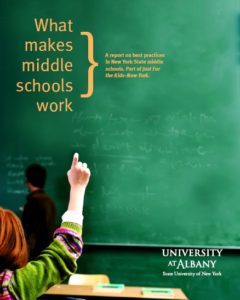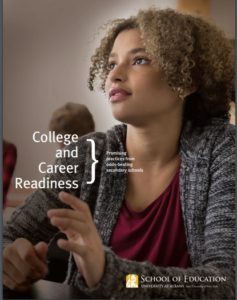20-20 NYKids Taking Stock: The Role of Social-Emotional Learning in Odds-Beating Schools
By Amanda Lester
Through this second installment in the NYKids 20-20 blog series, we look back at 15 years of NYKids’ research in schools across New York State to revisit past findings from the odds-beating schools, alongside lessons learned from more recent research, to explore how educators view the influence of out-of-school factors on student success and in what ways, if any, SEL has played a role in supporting student academic performance..
The Emerging Need for Social-Emotional Learning
Over the past several decades, improving student success outcomes has been a central focus in education policy. While policy during the era of No Child Left Behind (NCLB) (2002-2015) centered on in-school factors through accountability and testing, it became apparent that a variety of out-of-school factors also impact student success. Most often noted factors include poverty, mental and physical health, childhood trauma, and family instability.
Coupled with other changes, such as increased ethnic and linguistic diversity within schools and communities and a rising incidence of youth anxiety and depression, recognition of the growing presence of out-of-school factors prompted a shift in policy and practice that has helped to “reshape” teaching and learning. As educators have sought ways to address the effects of out-of-school factors on student learning, the promise and imperative need for high-quality social-emotional learning (SEL) to improve positive outcomes for students has come to the forefront.
What Makes Middle Schools Work?
In 2007, the NYKids team investigated 16 middle schools across New York State that served similar student populations to learn more about what “unusually effective schools” were doing that resulted in increased school performance on New York State Assessments of 8th grade English Language Arts and Mathematics in light of student demographic factors. Ten schools were identified as higher-performing (now called “odds-beating” schools), and the remaining six were described as demonstrating “average” performance (now called “typically performing” schools).
The study used site-based interviews with teachers and administrators, and analysis of supportive documentation, to examine differences in practice between odds-beating and typically performing schools. As with several other NYKids studies, interviews conducted in this study centered around the question: How do you define success? and a follow-up prompt: What helps you achieve success?
Trust and Respect Are the Foundations for Student Success
Findings from the 2007 study showed that higher-performing middle schools build a culture of success by consistently maintaining five common elements:
- Trusting and respectful relationships;
- Students’ social and emotional well-being;
- Teamwork;
- Evidence-based decision making; and
- Shared vision of mission and goals.
While the majority of these elements focused more on adult behavior than student-centered factors, the culture that resulted established a foundation of trust and respect for teaching and learning where staff and students’ emotional and social well-being became a central goal.
Further, definitions of success and the status of students’ social and emotional health were described as being facilitated through three processes: (1) removing barriers to learning; (2) taking care of transitions; and (3) ensuring safety. Of note among examples provided that demonstrated these processes, odds-beating Westbury Middle School offered a program for students struggling in mainstream classes that featured a low student-teacher ratio, county and state social services, and individualized behavior modifications to help students succeed academically and remain in the mainstream.
In addition to specialized student supports, educators shared other aspects of defining success as described through the ways they advanced students’ social and emotional well-being:
I think we define success at this middle school with a combo of academic success, not necessarily that everyone has level 3 or 4 [i.e., the level of proficiency on the State Assessments] …but also social and emotional growth, the ability to work in a group, be a member of a team and be a good citizen. –Vernon-Verona- Sherrill Middle School teacher
Each starfish [on the guidance bulletin board] represents a kid with some attention needs or other special needs. Teachers come in and pick one or two and focus on those kids. Students don’t know who has been chosen. –West Middle School teacher
2017-18 College and Career Readiness Study
In 2017-18, the NYKids research team embarked on a College and Career Readiness study of odds-beating high schools in New York State. This study again centered around the success question and included interviews with school and district administrators, teachers, and support staff. Although the focus of this study was at a different grade level, the intention was essentially the same, but its structure reflected shifts in policy and practice that had occurred since the 2007 middle school study. Research questions placed a greater emphasis on subjective criteria typically used to measure college and career readiness, such as student growth, sense of purpose, and self- and collective-efficacy rather than broader objective criterion, such as pass rates on State Assessments, as had been used in the earlier study.
Commonalities, Coherence, and Alignments
Findings from the 2017-18 study indicate four commonalities across odds-beating schools that offer insight into how educators in these schools achieve better outcomes. These include:
- Co-constructing a humanizing school community;
- Collaborating to define and achieve success;
- Cultivating culturally responsive, inclusive, and facilitative leadership; and
- Customizing innovative policies, programs, and practices.

The commonalities were found to be enacted through structural alignment across district, school, and classroom levels, and coherence was found through educators’ clarity and agreement about local priorities and how to achieve them. Educators described implementing priorities by differentiating student support in relation to the assets and resources that exist in the school and broader communities. In addition, students were involved in educational processes as active agents of their own learning.
Systems of student support noted in the 2017-18 study tended to be more youth-centered than those described in the 2007 study. Additionally, staff noted feeling supported by school administrators and the high value placed on professional collaboration. These factors resulted in school cultures that emphasize civility and shared responsibility among staff and students, thereby also empowering educators to serve as models and mentors for SEL processes.
You know [our first priority is] student success. Also, creating an environment where faculty, staff, and students feel comfortable and safe to express their ideas and where they can be in an environment where they are supported. – Freeport principal
We tend to work with a culture of “We’re going to give you [students] respect and we’re going to expect it back, and we are going to have conversations with you [students] when we see that that’s not happening.” But we are looking for that level of independence and being able to govern ourselves and work together, and that goes hand in hand with high expectations. – Alfred-Almond principal
While both studies found odds-beating schools to have a “humanizing culture” focused on supporting students’ social, emotional, and academic growth, the difference between findings from then and now shows a shift toward doing so with more intentionality and a greater emphasis on youth-centered pedagogical approaches. Similarly, the focus on student outcomes has shifted from goals centered around schoolwide efforts to raise student assessment scores to ensuring that individual students are prepared for life beyond high school in college, career, and as agents within their communities.
Looking Forward: NYKids Student Study
At the end of 2019, the NYKids team embarked on Phase II of the College and Career Readiness study to learn about how students define success in school. As SEL continues to play a stronger role in current policy and practice, having the student perspective will offer critical insight into how odds-beatings schools support students’ social, emotional, and academic development, as well as how students see those efforts influencing their learning and opportunities after high school.
Be sure to visit NYKids on the web, Facebook, and Twitter, and sign-up for our newsletters to catch the latest news about our current study and for future 20-20 blogs as we continue to look across 15 years of NYKids’ work to inform, inspire, and improve!



